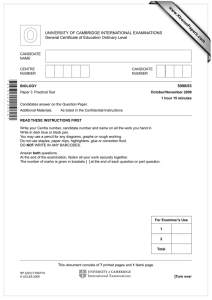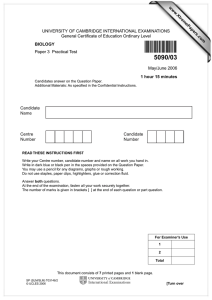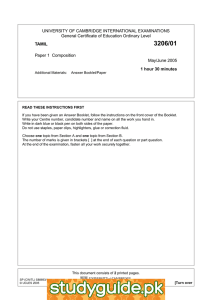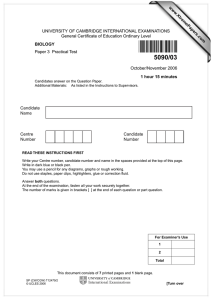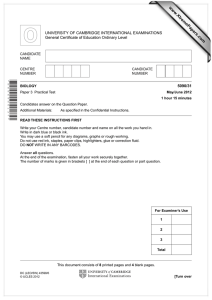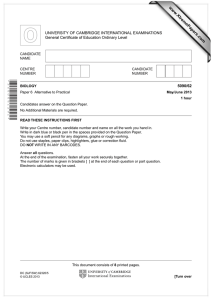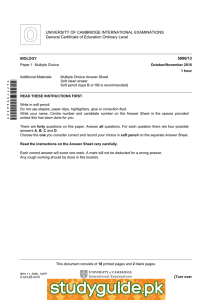UNIVERSITY OF CAMBRIDGE INTERNATIONAL EXAMINATIONS General Certificate of Education Ordinary Level 5090/03
advertisement
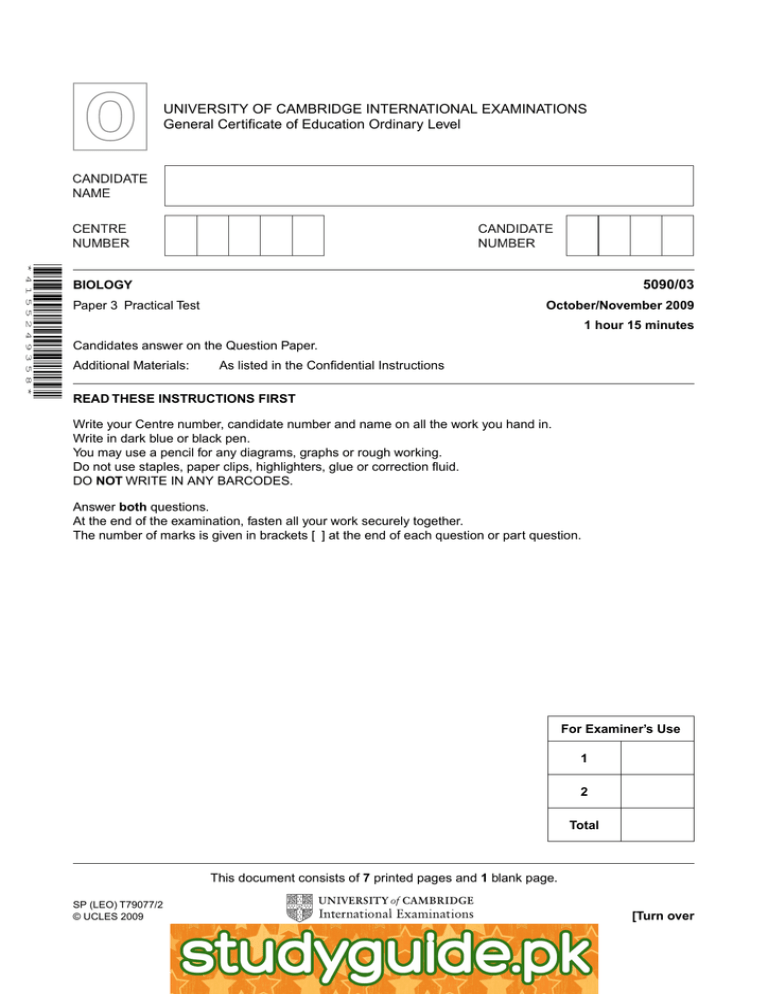
UNIVERSITY OF CAMBRIDGE INTERNATIONAL EXAMINATIONS General Certificate of Education Ordinary Level *4155249358* 5090/03 BIOLOGY Paper 3 Practical Test October/November 2009 1 hour 15 minutes Candidates answer on the Question Paper. Additional Materials: As listed in the Confidential Instructions READ THESE INSTRUCTIONS FIRST Write your Centre number, candidate number and name on all the work you hand in. Write in dark blue or black pen. You may use a pencil for any diagrams, graphs or rough working. Do not use staples, paper clips, highlighters, glue or correction fluid. DO NOT WRITE IN ANY BARCODES. Answer both questions. At the end of the examination, fasten all your work securely together. The number of marks is given in brackets [ ] at the end of each question or part question. For Examiner’s Use 1 2 Total This document consists of 7 printed pages and 1 blank page. SP (LEO) T79077/2 © UCLES 2009 [Turn over www.xtremepapers.net 2 1 You need to plan your answer before you start; read and follow the instructions carefully. (a) (i) Measure, and record in the grid provided, the lengths of twenty of the bean seeds in specimen W1. [1] (ii) Using your results, complete Table 1.1. Table 1.1 length number of seeds number of seeds, in group shortest longest [3] © UCLES 2009 5090/03/O/N/09 www.xtremepapers.net For Examiner’s Use 3 (iii) Construct a frequency diagram (bar chart or histogram) of the groups in the last column of Table 1.1. [5] (b) ‘Shorter bean seeds are the result of genetic inheritance rather than of the environmental conditions in which the parent plants were grown.’ Outline, giving practical details, an investigation to show if this is true. .......................................................................................................................................... .......................................................................................................................................... .......................................................................................................................................... .......................................................................................................................................... .......................................................................................................................................... .......................................................................................................................................... .......................................................................................................................................... .......................................................................................................................................... ......................................................................................................................................[4] © UCLES 2009 5090/03/O/N/09 www.xtremepapers.net [Turn over For Examiner’s Use 4 (c) • Take one of the soaked bean seeds, W2, carefully cut through the outer cover of the seed and remove this outer layer. • Apply enough pressure to separate the two parts of the seed. • Examine the inner surface of each piece and select the one that shows most of the embryo. • Examine the embryo with the hand lens. (i) Make a large, labelled drawing of the embryo, but do not include the cotyledon. [5] (ii) Calculate the magnification of your drawing in (c)(i). Rule a line across your drawing to show where you measured. Record your measurements and show all working clearly. Magnification = ………… [3] © UCLES 2009 5090/03/O/N/09 www.xtremepapers.net For Examiner’s Use 5 (d) • Remove and discard the cotyledon from the rest of the embryo. • Chop and crush the embryo into small pieces on a white tile. • Repeat these two steps for the second specimen, W2, and add it to the first crushed material on the tile. • Carry out the biuret test on the material on the tile by adding a few drops of Biuret reagent. • Place a similar number of drops of Biuret reagent on the tile so that you can compare the reagent on its own with the material being tested. (i) For Examiner’s Use State the result of this test. …………………………………………………………………………………………. ... [1] (ii) State your conclusion. …………………………………………………………………………………………. ... [1] (iii) Suggest the significance of your conclusion for the growth of the embryo. .................................................................................................................................. .................................................................................................................................. .................................................................................................................................. ..............................................................................................................................[2] [Total: 25] © UCLES 2009 5090/03/O/N/09 www.xtremepapers.net [Turn over 6 2 (a) (i) Describe how you can carry out the test for fat on specimens W3 and W4. Give practical details. For Examiner’s Use ……………………………………………………………………………………………… ……………………………………………………………………………………………… ……………………………………………………………………………………………… ………………………………………………………………………………………… .... [3] (ii) Carry out the test on W3 and W4. Complete Table 2.1. Table 2.1. observations conclusions W3 W4 [4] (b) Outline, but do not attempt to carry out, an experiment to show which of the specimens W3 and W4 contains the most energy. …………………………………………………………………………………………………… …………………………………………………………………………………………………… …………………………………………………………………………………………………… …………………………………………………………………………………………………… ………………………………………………………………………......................................... ...................................................................................................................................... [5] © UCLES 2009 5090/03/O/N/09 www.xtremepapers.net 7 (c) W3 and W4 have the same starch content. Use your conclusion in section (a)(ii) to explain the difference in energy content of W3 and W4. …………………………………………………………………………………………………… ………………………………………………………………………………………..………… …………………………………………………………………………………………………… …………………………………………………………………………… ............................. [3] [Total: 15] © UCLES 2009 5090/03/O/N/09 www.xtremepapers.net [Turn over For Examiner’s Use 8 Permission to reproduce items where third-party owned material protected by copyright is included has been sought and cleared where possible. Every reasonable effort has been made by the publisher (UCLES) to trace copyright holders, but if any items requiring clearance have unwittingly been included, the publisher will be pleased to make amends at the earliest possible opportunity. University of Cambridge International Examinations is part of the Cambridge Assessment Group. Cambridge Assessment is the brand name of University of Cambridge Local Examinations Syndicate (UCLES), which is itself a department of the University of Cambridge. © UCLES 2009 5090/03/O/N/09 www.xtremepapers.net
